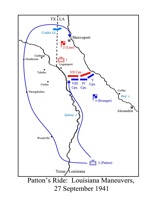Last week we looked at the opening round of the U.S. Army’s Louisiana Maneuvers in 1941. It was an exercise without a great deal of flash or excitement, but rather one designed to give a newly formed army some seasoning and a green officer corps some experience in maneuvering large formations in the field.
After four days to separate the armies, reorganize them, and return them to their start-lines, Phase 2 of the Louisiana maneuvers began. This time, the Blue Army (LTG Walter Krueger) was both twice as large as Red (LTG Ben Lear) and equipped with its own armored division, the 2nd, which had switched sides since Phase 1. Blue’s mission was advance upon and seize Shreveport, Louisiana. Krueger’s able chief of staff, COL Dwight D. Eisenhower, decided to send his armor on a wide sweep across the Sabine river to drive round Red’s western flank, break into the rear, and attack Shreveport from the north. The Red force was much smaller and tasked largely with positional defense for a 100-mile zone south of the city. Lear decided on a slow retreat, accompanied by massive demolitions that would slow down the pace of Blue’s advance.
Business as usual so far, but we need to introduce another factor into the equation. Some of you have no doubt read Malcolm Gladwell’s 2008 book Outliers. In science, “outliers” are anomalous events that cannot be described by theory. Gladwell believes that there are people we can consider outliers, “men and women who, for one reason or another, are so accomplished and so extraordinary and so outside of ordinary experience that they are as puzzling to the rest of us as a cold day in August.” Gladwell argues that every organization has its outliers, and that successful ones know how to use them and put their talents to good use. Indeed, this phase of the maneuvers would feature one of the greatest outliers in U.S. military history. Commanding Blue 2nd Armored Division on its great ride west would be none other than “Mr. Outlier” himself, MG George S. Patton, Jr.
 Patton showed his flair for maneuver by launching his division on a top speed, 3-day, nearly 400-mile end run into Texas, passing through Woodville, Nacogdoches, and Henderson and slashing into the rear of the Red position (see map). By the end of the maneuver on September 29th, he had fought his way to the outskirts of Shreveport , and one of his reconnaissance battalions had actually overrun Barskdale airport, the headquarters and principal base of Red’s 2nd Air Task Force, and taking the entire staff prisoner. The Red command seemed paralyzed by the threat, and in fact Lear would protest that Patton had taken his division outside of the legal maneuver area. According to one biographer, Patton came back with a snarky “I am unaware of the existence of any rules in war.” During his ride through Texas, he had actually supplied himself through purchases made from local gas stations along the route (rather than the approved 5-gallon “jerry can” then in official use, hundreds of which were needed to fuel an armored unit).
Patton showed his flair for maneuver by launching his division on a top speed, 3-day, nearly 400-mile end run into Texas, passing through Woodville, Nacogdoches, and Henderson and slashing into the rear of the Red position (see map). By the end of the maneuver on September 29th, he had fought his way to the outskirts of Shreveport , and one of his reconnaissance battalions had actually overrun Barskdale airport, the headquarters and principal base of Red’s 2nd Air Task Force, and taking the entire staff prisoner. The Red command seemed paralyzed by the threat, and in fact Lear would protest that Patton had taken his division outside of the legal maneuver area. According to one biographer, Patton came back with a snarky “I am unaware of the existence of any rules in war.” During his ride through Texas, he had actually supplied himself through purchases made from local gas stations along the route (rather than the approved 5-gallon “jerry can” then in official use, hundreds of which were needed to fuel an armored unit).
Patton emerged from Louisiana one of the army’s rising stars and would be heard from again. Indeed, the maneuvers determined the cohort of field commanders who would fight the war in Europe. Of the 42 divisional, corps, and army commanders who took part in the fall exercises, U.S. Army Chief of Staff General George C. Marshall would relieve or pushed aside 31 to make way for younger officers. It had taken a while, and it was just in time, but the U.S. Army was getting ready to rumble.
The Louisiana Maneuvers were indeed a reflection of a U.S. “way of war” as it had evolved over a century and a half. It was an army that preferred the broad-front advance to the single-axis penetration. It ground you down, it didn’t slice you up. And yet, it also had its share of “outliers,” freethinkers who didn’t mind tearing up the rulebook. Finally, the maneuvers showed that there was one thing this army could do, something that it would prove it again and again in the ETO: if it found a seam, some operational elbow room, it could move like lightning. You took your eyes off the U.S. Army at your own risk. It was something that the Wehrmacht would have to discover, but might already have known if it had paid any attention at all to the Louisiana maneuvers.
For more discussion of the war, the latest news, and announcements, be sure to visit World War II Magazine’s Facebook page.




